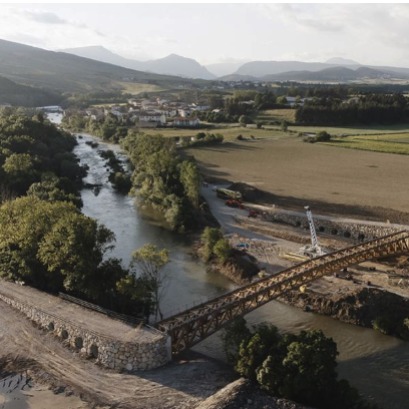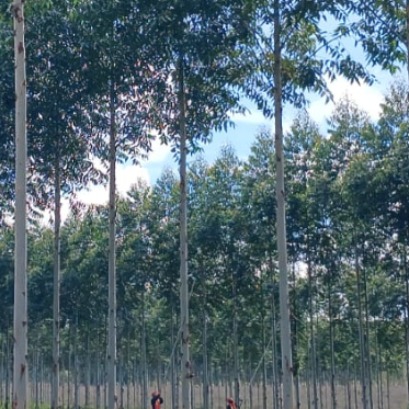
Spain | In Navarra they built the longest industrialized pedestrian walkway in the world on the Arakil River
The Navarra Foral Community celebrated a new achievement of sustainable engineering with the installation of the longest wood pedestrian walkway in the world. With a length of 86.8 meters, the structure connects the river walk between the towns of Ibero and Etxauri, on the Arakil River, without intermediate pillars and with an innovative arc structure.
The work was executed by the Madergia company, a reference under construction in wood, which manufactured and assembled the catwalk in its Aoiz plant, dividing the project into eight sections that were then transported to the site and mounted with precision by large cranes of large tonnage. With a total weight of 106 tons, the catwalk was installed on stirrues previously founded on both banks of the river. The structure is about 350 meters from the town of Ibero, next to the confluence of the Arakil and Arga rivers. Upon the moment, the previous records of longer wood pedestrian catwalks were: that of the Guadalhorce River (Spain, 70 meters), that of the Neckar River (Germany, 80 meters), that of the Bow River (Canada, 80 meters) (China, 76 meters) and Anaklia (Georgia, 84 meters). With its 86.8 meters, the new Navarra catwalk exceeds all these brands. The project is part of the expansion of the river walk of the Pamplona region, adding a new section of 4,468 meters. This extension will improve pedestrian and cycling connectivity between the towns of Ibero and Etxauri, reinforcing the green network that already reaches 63 kilometers of travel. The award budget of the work was 1,930,674.68 euros (without VAT), of which 850,000 euros were financed by the recovery, transformation and resilience Navarra This action is part of the Tourist Sustainability Plan in the region of the Rural Pamplona. In the coming months, the conditioning of the remaining sections of the walk with recycled or concrete arid pavement will be completed, depending on the terrain conditions and its vulnerability to floods. This new section adds to the previous extensions made in the ELORZ River section (2023), with 7 kilometers between the CENDEAS of Cizur and Galar, and the section of Bajo Arga (2021), between Arazuri and Ibero, with 5.2 kilometers next to the river. The installation of this catwalk represents an outstanding example of sustainable engineering, active tourism and territorial development with criteria of low environmental impact and high patrimonial value for Navarra.
IT MAY INTEREST YOU
 Paraguay | The plantations became instruments of territorial development and the generation of decent employment, INFONA highlights.
Paraguay | The plantations became instruments of territorial development and the generation of decent employment, INFONA highlights.
Plantings in different phases, control of ants and weeds, pruning and thinning, mechanized harvest, technology applied to the field and complete integration of the production cycle were part of the CREA Forestal proposal in its Technical Update Conference – JAT Forestal 2025. The event took place on Friday, November 14, at Estancia Ñemity, located in San Juan Nepomuceno, Caazapá, where agricultural producers, technicians, contractors, students and companies in the sector met to observe the forestry business of the future in action.
 Experts cant believe it, but this tree is the oldest in the world and continues to bear fruit: it is 4,000 years old.
Experts cant believe it, but this tree is the oldest in the world and continues to bear fruit: it is 4,000 years old.
Nature keeps secrets that defy the passage of time, and one of the most surprising examples is a tree that, approximately 4,000 years old, continues to bear fruit today. This specimen has become a symbol of resistance and longevity, capable of surviving climate changes, landscape transformations and human activity itself.
 The second largest wetland in South America is located in Argentina: what is it?
The second largest wetland in South America is located in Argentina: what is it?
Argentina has national parks that place it in a unique position within South America, competing with 300 others. Which is the largest? South America is home to more than 300 national parks, but many go unnoticed. There are extensive wetlands that have been the subject of major ecological restoration projects, to coastal mountains with deep indigenous heritage. Today we tell you the case of one located in Argentina.





















